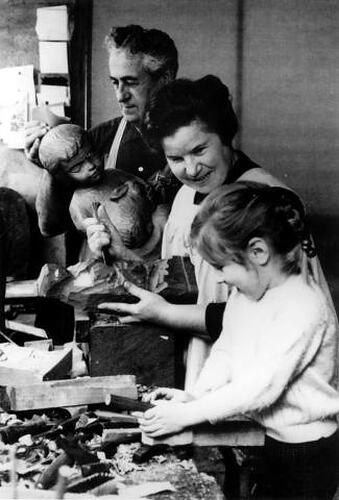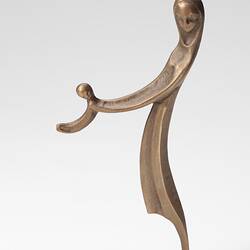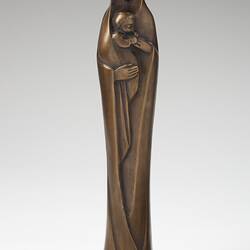Leopoldine (Poldi) Mimovich was born in 1920 and grew up in the village of Sankt Johann in the Pongau region of Austria (now a part of Italy). She studied sculpting in Vienna and then later at the School of Wood Sculpture in Hallstatt from 1943 to 1949. She married Ljubisa (Leo) Mimovich, a Serbian, who had been held in a prisoner of war camp near Leopoldine's village. When the couple were married Poldi lost her Austrian citizenship and so had to emigrate. She and Lou initially applied to migrate to America, where Poldi's aunt was living. However their application took a long time to process, so they applied to migrate to Australia as well and decided to accept whichever application was approved first.
Poldi's initial migration experience was very traumatic. They travelled to Australia on the ship, MV Skaugum during which Poldi became extremely ill. They were initially sent to the Bonegilla Reception and Training Centre in Northern Victoria which Poldi found bleak, and suffering homesickness and the frustration of being unable to practice her craft. Poldi recalls 'it was very, very boring in Bonegilla. When the luggage came after a fortnight, I had two masks in there. We went to the official and I said I would give him a mask if he put us on the transport to Melbourne a bit earlier. We knew that you went to Melbourne to work, so then we could begin a normal life' (Leopoldine Mimovich interview, 1992). The camp official accepted the carving and Poldi and Leo were transferred to the Royal Park Migrant Camp in Melbourne, where they could begin their two-year labour contracts, Leopoldine in a shirt factory and Lou at Hoffman's brickworks. Poldi then moved to Myer department store where she worked in the furniture carving department for a number of years; during this time she also began doing commissioned carvings. Throughout this period she found the industry to discriminate against women, whose work was less respected and financially undervalued.
Poldi and Leo finally purchased a house in the Melbourne eastern suburbs where she set up her studio and undertook commissions which reflected her Austrian traditions and Catholic background. Over time her work evolved into a more impressionistic, free- flowing form and adopted local materials such as Huon pine. Poldi's works are represented in numerous churches and public buildings around the country.
References
Leopoldine Mimovich interview, August 1992
Deborah Tout-Smith 'Contemporary Craft and Cultural Identity' Project Report, Museum Victoria, 1992
More Information
-
Keywords
Cultures and histories : Melbourne and Victoria, immigration, World War II, artists, art
-
Authors
-
Article types




